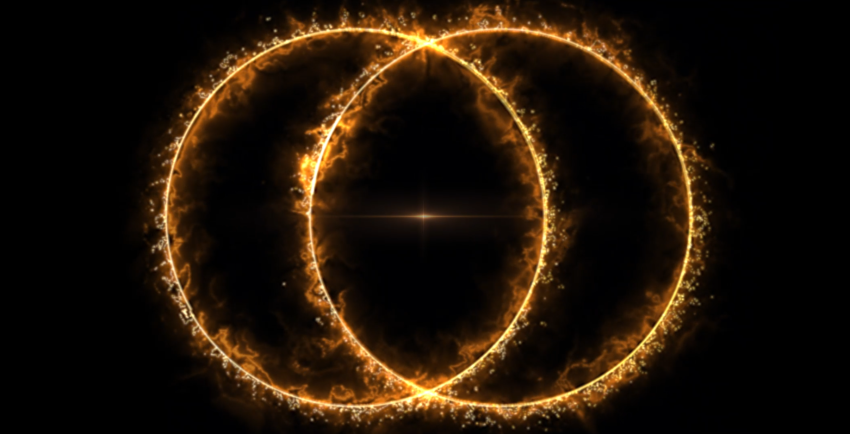Science
Astronomers Discover Stunning Double-Ring Formation in Distant Galaxy

Astronomers have made a remarkable discovery involving a distant galaxy that is enveloped by two enormous, intersecting rings of radio light. These rings, each approximately 300,000 light-years wide, are part of a phenomenon known as an “Odd Radio Circle” (ORC). The find was made by volunteers participating in the RAD@home Astronomy Collaboratory, a citizen-science initiative based in Mumbai.
The newly identified ORC, designated RAD J131346.9+500320, is not only the most distant but also the most powerful ORC recorded to date. It is located so far away that astronomers observe it as it appeared when the universe was only half of its current age of 13.8 billion years. This extraordinary double-ring formation has only been observed once before.
Unraveling Cosmic Mysteries
According to Ananda Hota, founder of the RAD@home program, “ORCs are among the most bizarre and beautiful cosmic structures we’ve ever seen.” He added that these formations may provide crucial insights into how galaxies and black holes evolve together. The discovery has been detailed in the Monthly Notices of the Royal Astronomical Society, marking it as a significant contribution to astronomical research.
The rings exist within an even larger radio cloud that extends nearly 3 million light-years. The origin of these ORCs remains a mystery, with possibilities ranging from shockwaves caused by merging black holes or galaxies to powerful cosmic winds reshaping the material in their vicinity. So far, scientists have identified only a handful of ORCs, with most being 10 to 20 times larger than the Milky Way.
The identification of RAD J131346.9+500320 is particularly noteworthy as it was the first ORC discovered through citizen-assisted science and the first identified using the LOFAR network, which consists of antennas distributed across the Netherlands and other European nations. These cosmic structures are detectable solely by radio telescopes, making this discovery even more significant.
Volunteer Contributions and Further Findings
The discovery stemmed from volunteers using their own vision to examine deep space maps, looking for patterns that automated systems may have overlooked. In addition to the remarkable double-ring ORC, the program also identified two other examples. One, designated RAD J122622.6+640622, revealed a galaxy nearly 3 million light-years across, where one of its jets formed a curved structure, producing a ring of radio light approximately 100,000 light-years wide.
Another example, RAD J142004.0+621715, displayed a similar ring at the tip of one of its jets, while showcasing another narrow jet on the opposite side of the host galaxy. As these discoveries unfold, scientists believe they demonstrate that galaxies can influence their surroundings in ways not previously understood.
According to Pratik Dabhade, a coauthor from the National Centre for Nuclear Research in Poland, “ORCs and radio rings are not isolated curiosities. They are part of a broader family of exotic plasma structures shaped by black hole jets, winds, and their environments.” This perspective emphasizes the importance of these findings in the context of galactic evolution and the dynamics of the universe.
The ongoing research into ORCs not only enhances our understanding of the cosmos but also highlights the valuable contributions of citizen scientists in advancing astronomical knowledge.
-

 Health3 months ago
Health3 months agoNeurologist Warns Excessive Use of Supplements Can Harm Brain
-

 Health3 months ago
Health3 months agoFiona Phillips’ Husband Shares Heartfelt Update on Her Alzheimer’s Journey
-

 Science2 months ago
Science2 months agoBrian Cox Addresses Claims of Alien Probe in 3I/ATLAS Discovery
-

 Science2 months ago
Science2 months agoNASA Investigates Unusual Comet 3I/ATLAS; New Findings Emerge
-

 Science1 month ago
Science1 month agoScientists Examine 3I/ATLAS: Alien Artifact or Cosmic Oddity?
-

 Entertainment5 months ago
Entertainment5 months agoKerry Katona Discusses Future Baby Plans and Brian McFadden’s Wedding
-

 Science1 month ago
Science1 month agoNASA Investigates Speedy Object 3I/ATLAS, Sparking Speculation
-

 Entertainment4 months ago
Entertainment4 months agoEmmerdale Faces Tension as Dylan and April’s Lives Hang in the Balance
-

 World3 months ago
World3 months agoCole Palmer’s Cryptic Message to Kobbie Mainoo Following Loan Talks
-

 Science1 month ago
Science1 month agoNASA Scientists Explore Origins of 3I/ATLAS, a Fast-Moving Visitor
-

 Entertainment2 months ago
Entertainment2 months agoLewis Cope Addresses Accusations of Dance Training Advantage
-

 Entertainment3 months ago
Entertainment3 months agoMajor Cast Changes at Coronation Street: Exits and Returns in 2025









